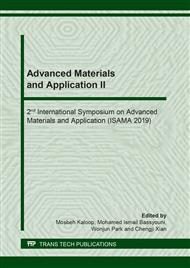p.88
p.94
p.100
p.109
p.116
p.122
p.128
p.134
p.141
The Influence of Stainless Steel Mesh Porous Burner on Drying Kinetics of Nile Tilapia
Abstract:
This paper studied the influence of porous burner effect on drying kinetics of Nile tilapia drying using stainless steel mesh porous burner as heat source. Drying kinetics was analyzed by determination of drying rate (DR), drying specific energy consumption (SEC) and dryer thermal efficiency (). In this study, the stainless steel mesh was used as porous media with porosity of 10, 20 and 50 pore per inch (PPI), drying air velocity of 0.5, 1.0 and 1.5 m/s, and drying temperature of 50, 60 and 70 °C, respectively. The results were found that the application of porous burner as heat source can improve the drying kinetics. It was found, at the porosity of 50 PPI, the drying temperature of 70 °C and the air velocity of 1.5 m/s, the moisture ratio of the drying was decreased rapidly, the highest drying rate was found to be 150 g (water evap.)/hr., the lowest drying energy consumption was found to be146.75 MJ/kg, and the thermal efficiency of the dryer was found to increase by 17.79% and the CO and NOx concentration in case of applying porous burner as heat source is lower than without porous burner.
Info:
Periodical:
Pages:
116-121
Citation:
Online since:
June 2019
Authors:
Keywords:
Price:
Сopyright:
© 2019 Trans Tech Publications Ltd. All Rights Reserved
Share:
Citation:


